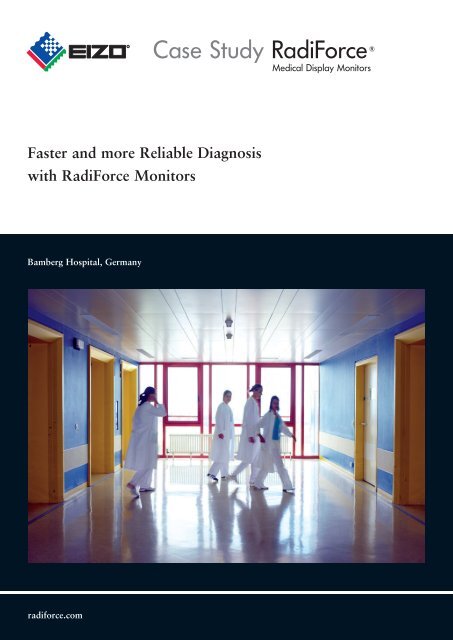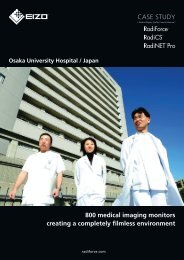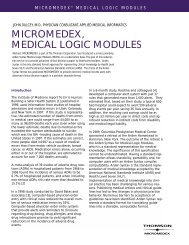Klinikum Bamberg Hospital - Eizo
Klinikum Bamberg Hospital - Eizo
Klinikum Bamberg Hospital - Eizo
Create successful ePaper yourself
Turn your PDF publications into a flip-book with our unique Google optimized e-Paper software.
Case Study RadiForce ®<br />
Medical Display Monitors<br />
Faster and more Reliable Diagnosis<br />
with RadiForce Monitors<br />
<strong>Bamberg</strong> <strong>Hospital</strong>, Germany<br />
radiforce.com
“Of course the quality<br />
of our diagnostic monitors<br />
is highly important.<br />
And I’m very satisfied<br />
with EIZO.<br />
My colleagues, too.”<br />
Dr. Hans Schneider<br />
Senior Physician, Institute of Radiology,<br />
<strong>Bamberg</strong> <strong>Hospital</strong><br />
Hans Schneider has been a senior physician in the Institute for Diagnostic and Interventional Radiology<br />
and Nuclear Medicine at <strong>Bamberg</strong> <strong>Hospital</strong> for the past five years. Together with his colleague,<br />
Dr. Sieglinde Spindler-Thiele, he is the head of the PACS Task Force and was of course eager to see the<br />
system introduced.<br />
The Speed Advantage<br />
For the radiologist Dr. Schneider speed is an important part of his work, as he needs to make his diagnosis<br />
quickly and reliably, so that the appropriate treatment may begin. Equally important is the follow-up<br />
monitoring of the therapy, and that these results are transferred just as quickly to his colleagues in the<br />
other clinical wards.<br />
Such speed and efficiency can only be achieved with a picture archiving and communications system (PACS).<br />
<strong>Bamberg</strong> <strong>Hospital</strong> (<strong>Klinikum</strong> <strong>Bamberg</strong>) has recently introduced such a system, consisting PACS and EIZO<br />
RadiForce monitors. “With this new system we save an extra one or even two days”, enthusiastically<br />
Hans Schneider. This is all the more important for a modern, cost-conscious hospital, since patients are not<br />
factored merely according to the length of stay but also in terms of their diagnosis.<br />
“Diagnosis is now considerably faster; we don’t have to search for images” continues the radiologist.<br />
“In the past when a colleague phoned and asked ‘Can you take a look at the thorax?’<br />
I replied ‘Where's the film?’, or ‘Come here and bring the film.’ Now I just go to the nearest console and<br />
look at the image for myself. Then I can give him my opinion within 30 seconds.” Fast decisions like these<br />
are often critical to the therapy: If a query comes from the intensive care unit as to whether particular<br />
action needs to be taken or not, and the radiologist is immediately able to confirm or rule out the need to<br />
operate then this is obviously beneficial for the patient concerned.
Combined Knowledge and Experience<br />
The digital distribution of the images also means that if, for example, a physician in outpatients has a<br />
question for the surgical department or the senior consultant, then the whole diagnostic team is able to<br />
look at the images at the same time, regardless of where they are, and decide if and when to operate.<br />
Dr. Schneider explains that “here in our Radiology department we don’t train our staff to become pure<br />
specialists; any one of the team can analyze 80% of the images.” The PACS, along with EIZO RadiForce<br />
monitors, allows any of the radiologists to access all the images, so that they can diagnose everything –<br />
with the added bonus that the Institute remains flexible in terms of staffing. In addition, the physicians<br />
are able to define their own user profiles within the system, so that only those images which concern them<br />
are displayed, regardless of which station they are using.<br />
The quality of the monitors is of course highly important, throughout the entire diagnostics process, as<br />
Dr. Schneider is all too aware: “There are certain legal requirements to be met, and you have to have<br />
a good feeling about the monitor. And I’m very satisfied with EIZO. My colleagues, too.”<br />
radiforce.com
“We looked for a partner<br />
who could provide the whole<br />
spectrum of monitors, and<br />
with an optimum cost-effectiveness<br />
ratio. This is why we<br />
decided to use EIZO.”<br />
Rapid Implementation of a Global System<br />
As one of the leaders of the <strong>Hospital</strong>'s PACS Task Force, Dr. Schneider was pleased to see how motivated<br />
both the radiologists in his team and the clinical physicians were in supporting the fast and smooth<br />
implementation of the project. In fact, the introduction of the PACS took just 18 months – from the first<br />
consultation to its authorized launch. This was made possible by close cooperation with an experienced<br />
external consultant, Martin Neumann of MedServ. In fact, a rapid implementation is part of MedServ policy:<br />
The longer a project takes, the more opportunities arise for hindering factors, and the user acceptance is<br />
likely to suffer.<br />
<strong>Bamberg</strong> <strong>Hospital</strong> already had an RIS and HIS, so an interface to the existing system was an integral part<br />
of the contract. Another stipulation was the supply of TFT monitors throughout the <strong>Hospital</strong>. This was thus<br />
a global project for EIZO, with the hospital management clearly stating that if EIZO RadiForce monitors<br />
were to be implemented in the Radiology Institute, then everyone should have them.<br />
EIZO Wins the Contract<br />
Therefore, the <strong>Hospital</strong>, together with MedServ, was looking for a partner who could provide the whole<br />
spectrum of monitors, meeting the various requirements dictated by different workplaces – and with<br />
an optimum cost-effectiveness ratio. It is also worth mentioning here that the monitors in question have to<br />
operate 24 hours a day, 365 days a year.<br />
This is why the decision was taken to use EIZO.<br />
All the relevant EIZO monitors with their various specifications were presented to the <strong>Hospital</strong> on one day,<br />
allowing the staff involved to actively participate in the decision process and to increase acceptance<br />
of the new system and its hardware. In total, <strong>Klinikum</strong> <strong>Bamberg</strong> has around 750 workplaces using EDP<br />
equipment, plus there are another 200 EDP workplaces at the St. Gertreu Psychiatric Clinic, which is<br />
linked to the <strong>Hospital</strong> by a direct dark fiber line and which comes under <strong>Bamberg</strong> <strong>Hospital</strong>'s supervision.
“Every hospital will need<br />
to have this system<br />
if it wants to remain<br />
competitive.”<br />
Investing in the Future<br />
The <strong>Hospital</strong> expects a return on its PACS investment within the next four years. The introduction of the<br />
new system entails certain direct financial benefits, such as savings on X-ray film, developer, waste<br />
chemicals disposal, or space needed for archiving film. There are also the numerous incalculable savings<br />
derived from faster access to images, saving time previously spent searching, and resulting in a more<br />
relaxed work atmosphere.<br />
A <strong>Hospital</strong> with a Tradition of Innovation<br />
<strong>Bamberg</strong> <strong>Hospital</strong> is situated in Northern Bavaria, Germany, and has a catchment area extending to<br />
around 50 km. It is integrated within and owned by a social foundation, which also includes the<br />
St. Getreu psychiatric clinic.<br />
The <strong>Hospital</strong> itself has a total of 760 beds, and covers the entire medical spectrum, with the exception<br />
of neurosurgery and transplantations. One of the main areas of focus is gynecology, and <strong>Bamberg</strong> <strong>Hospital</strong><br />
has its own Breast Center, where mammography plays a crucial role.<br />
The current modern building is 20 years old, and replaced the town's former hospital, which was<br />
originally built in 1789. For many years this was the most modern hospital in the whole of Europe, so<br />
that today its successor feels a sense of duty to remain true to these innovative origins.<br />
<strong>Klinikum</strong> <strong>Bamberg</strong> is also the medical school for the Friedrich-Alexander University in nearby Erlangen<br />
and Nuremberg.<br />
radiforce.com
“We decided to use EIZO since<br />
these are the best<br />
products.”<br />
Brigitte Dippold<br />
Quality Manager at <strong>Bamberg</strong> <strong>Hospital</strong><br />
The Radiology Institute<br />
Headed by senior consultant Dr. Manfred Schmidt, the Institute for Diagnostic and Interventional<br />
Radiology and Nuclear Medicine (with its department for isotope diagnostics and isotope therapy)<br />
comprises three senior physicians, two specialists, five interns, 23 MTRAs and six nurses.<br />
With computer tomography, magnet resonance imaging and ultrasound, the Institute utilizes all modern<br />
imaging techniques, which are also applied to interventional operations. The Institute processes<br />
100-120,000 images annually, representing around 260 examinations each day – most of which result<br />
from MRI and CT.<br />
Streamlined Diagnostics<br />
The <strong>Hospital</strong> decided to introduce the PACS to enhance interdisciplinary cooperation between the<br />
radiologists and the clinical departments. The system has the crucial benefit that the digital images are<br />
always available whenever and wherever they are needed. As Brigitte Dippold, Quality Manager at<br />
<strong>Bamberg</strong>. <strong>Hospital</strong>, comments: “Now there's no need to search for the images, and that saves both time<br />
and money – as well as improving the treatment of our patients.”<br />
In terms of quality management, process optimization is an important step towards quality assurance,<br />
and Ms. Dippold considers it “impossible to optimize processes within a radiology department without<br />
a PACS.” The Quality Manager adds that when the <strong>Hospital</strong> introduced its PACS, the decision to use<br />
EIZO was taken “since these are the best products.”<br />
RadiForce for Reliability<br />
The Institute for Diagnostic and Interventional Radiology has a total of 9 diagnostic stations plus a<br />
mammography console, all of them equipped with EIZO RadiForce monitors, which of course conforming<br />
to all the legal requirements. Each station has three monitors – two diagnostic monitors plus a console<br />
for displaying the radiology information system (RIS) data – with an integrated digital dictation system for<br />
the radiologists to directly input their diagnostic comments.
HIS/RIS/PACS communication at <strong>Bamberg</strong> <strong>Hospital</strong><br />
<strong>Bamberg</strong> <strong>Hospital</strong> is linked by a dark fiber line to the town's psychiatric clinic, allowing for the<br />
transmission of digital data via HIS, RIS and PACS. The system is Web-based and designed for further<br />
external connections in the future, including teleradiology.<br />
The <strong>Hospital</strong> stores all its images digitally, including reconstructions taken from various sections.<br />
In line with insurance and legal requirements, the images are stored between 10 years (accident patients)<br />
and 30 years (therapy patients).<br />
The server contains the patient database plus all the images in both compressed and uncompressed form,<br />
since compressed files suffice in 98 % cases in the periphery. This saves considerably on network traffic,<br />
further streamlining the PACS, and is one of the major advantages of the Fuji system.<br />
All the data is stored twice and in a parallel (redundant) system, completely independent of each other.<br />
This protects the data from fire, water or other types of damage. The 1.2 terabyte of storage space (RAID)<br />
is designed in a modular way, and thus can be extended as desired.<br />
<strong>Bamberg</strong> and EIZO set the Standard<br />
Since <strong>Bamberg</strong> <strong>Hospital</strong> introduced its PACS and EIZO RadiForce monitors, representatives of other clinics<br />
have come to visit and find out about the system. <strong>Klinikum</strong> <strong>Bamberg</strong> offers them the opportunity to<br />
see a successful system in operation for themselves. This has helped to enhance the positive image of the<br />
<strong>Hospital</strong>, since its PACS is regarded as the standard by which others are measured.<br />
As Dr. Schneider points out, “the speed advantage and subsequent earlier start of therapy means that in<br />
future every hospital will need to have this system if it wants to remain competitive.”<br />
radiforce.com
EIZO NANAO CORPORATION<br />
153 Shimokashiwano, Matto Ishikawa 924-8566 Japan<br />
Phone: +81-76-277-6792 Fax: +81-76-277-6793<br />
Information on the products is available at the RadiForce official site http://radiforce.com<br />
All product names are trademarks or registered trademarks of their respective companies. EIZO and RadiForce are registered trademarks of <strong>Eizo</strong> Nanao Corporation.<br />
Copyright © 2004 <strong>Eizo</strong> Nanao Corporation. All rights reserved. Published in September, 2004. (040905) Printed in Germany, September, 2004, 2K




